#sefarad
Note
Hi!
Do you know if there's any Jewish history in EH? There are a lot of old (pre-Inquisition) Jewish buildings/art in Spain, Catalonia, and Portugal, but I'm not sure if there are EH. I'm just curious, since I've learned a lot about Jewish life in Spain before the Inquisition, but never about Jewish life in EH, if there even was any.
Thank you!
Kaixo and thanks for your message!
Of course there's Jewish history in EH! In Gipuzkoa there never was a big community, as well as in Araba, with the exception of Guardia. In Bizkaia, Balmaseda was the biggest center for Jews, but sadly they were forcibly expelled around 40 years prior to the expulsion from Castile. Jewish people flourished mainly in the southern side of Nafarroa in Muslim times: there were thriving Jewish communities in Lizarra, Tutera, Tafalla, even Iruña.
Luckily this didn't change after the Reconquista! Jewish people were mainly merchants and moneylenders - profession banned for Christians - and they would work with peasants and nobility alike. They were also wine makers, and this wine was very much appreciated not only in the kingdom of Navarre, but also in Aragón and Castile. Navarrese kings supported Jewish communities and welcomed any Jew from other region.
There's a tragic but moving story about this time. The Jewish community of Gasteiz was forced to leave, but they agreed to hand over their cemetery to the city on the condition of respect the ground and don't build on it. The promise was respected for 460 years until 1952, when Jewish representatives agreed with the town hall that the ground was available for any use. Nowadays, it's a park with this monument to Jewish people. The neighborhood is called Judimendi, "the mountain of Jewish people".
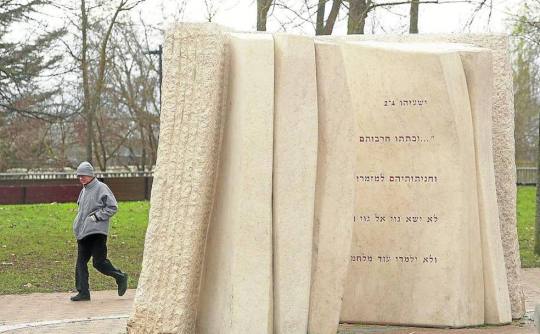

In fact, when the kingdom of Castile ordered the expulsion of Jews from Castile, most of them moved to the kingdom of Navarre. But after the conquest by Castile in 1512, Jews and Muslims were effectively expelled from their home. Most of them didn't go too far, just across the border, to Baiona.
Baiona welcomed Basque, Spanish and Portuguese Jews, gathering a very important community that led to call the town the little Jerusalem at one time. There's a much modern legacy there than south the border, for example, there's still a functioning synagogue.


After the French revolution, Jews were reocgnised the same rights and duties than any other French, so they kept their businesses and in Baiona, many of them devoted themselves to chocolate - still one of the best in Europe, I must add.
But during WW2 and nazi occupation, maaaany of these Jewish people were captured and led to extermination camps. The community didn't die, though, and they welcomed a new wave of Jewish refugees in the 60s due to the French-Algerian war.
René Cassin, one of the fathers of the Declaration of Human Rights, was a Jew from Baiona, btw.
Nowadays in Euskadi there are just around 300 Jews, while in Iparralde this figure is bigger but not super high (just around ~3,000 in the whole Aquitaine).
53 notes
·
View notes
Text
The book poll ended, first of all, thank you for voting @isadomna @asongofstarkandtargaryen @jackredfieldwasmyjacob @queenmiriamele @mortalsilence and the other people who particiated!
In total, there are 15 votes and these are 6 books that I'll be sharing during the following weeks/months:
• AL-ANDALUS. Personajes históricos (Al Andalus. Historical figures) 26, 7% - 4 votes
• Toledo: La ciudad de los muertos (Toledo: The city of the dead) 26,7% - 4 votes
• AL-ANDALUS. Ocho siglos de civilización musulmana que marcaron la historia y la cultura de España (AL ANDALUS. Eight centuries of Muslim civilization that marked the history and culture of Spain) 20% - 3 votes
• España medieval : el origen de las ciudades (Medieval Spain: the origin of the cities) 13, 3% - 2 votes
• Valle-Inclán y el insólito caso del hombre con rayos x en los ojos (Valle-Inclán and the unusual case of the man with x-rays in his eyes) 6,7% - 1 vote
• De Mayrit a Madrid: Madrid y los árabes del siglo IX al siglo XXI (From Mayrit to Madrid: Madrid and the Arabs from the 9th century to the 21st century) 6,7% - 1 vote
The other 6 options that are left didn't receive any votes but I'll include them in another poll with some other books.
I'll try to share at least the corresponding parte of a book once a week.
As I had mentioned, for the book Toledo: La ciudad de los muertos, I had already shared the first pages:
#bookblr#historyblr#history books#spanish history#al andalus#sefarad#al andalus. personajes históricos#toledo la ciudad de los muertos#al-andalus. ocho siglos de civilización musulmana que marcaron la historia y la cultura de españa#españa medieval : el origen de las ciudades#valle-Inclán y el insólito caso del hombre con rayos x en los ojos#de mayrit a madrid: madrid y los árabes del siglo IX al siglo XXI#al andalus. historical figures#toledo city of the dead#al andalus. eight centuries of muslim civilization that marked the history and culture of spain#medieval spain: the origin of the cities#valle-inclán and the unusual case of the man with x-rays in his eyes#from mayrit to madrid: madrid and the arabs from the 9th century to the 21st century#history
4 notes
·
View notes
Text

Beautiful old kiddush bottle from Damasco, s. XIX
#jewish heritage#kidush#jumblr#antique#kidush bottle#jews and judaism#esefarad#sephardic#sephardim#sefarad
12 notes
·
View notes
Text
Sefarad Yahudileri, Rodrigo Jerez ve Tütünün İlk Kurbanı
Sefarad Yahudileri, Rodrigo Jerez ve tütünün ilk kurbanından oluşan ve ilk bakışta üç benzemez gibi görünen bir başlığı biraz şaşırtıcı bulmuş olabilirsiniz.
SEFARAD YAHUDİLERİ,RODRİGO JEREZveTÜTÜNÜN İLK KURBANI
Sefarad Yahudileri, Rodrigo Jerez ve tütünün ilk kurbanından oluşan ve ilk bakışta üç benzemez gibi görünen bir başlığı biraz şaşırtıcı bulmuş olabilirsiniz.
Birazcık sabredip yazının sonuna geldiğinizde bu üçlemenin aslında gayet anlamlı bir bütün oluşturduğunu göreceksiniz.
Hadi konumuza dönelim…
Tütün tiryakisi olmanın tarih boyunca ne…

View On WordPress
0 notes
Text
Sefarad e Hispanidad. Judío sefardita e hispanista no es excluyente, sino complementario.
En este programa de Unión Hispano Americana, exponemos la obviedad de que ser Judío sefardita e hispanista, no es un factor excluyente, sino que es complementario, llegando a la conclusión de que el hispanismo no es monopolio del catolicismo, ni de ningun
Se estrenará el vídeo hoy 15 de julio, 16:30 hora de España y la Guinea hispana, 6 o 7 horas menos en Hispano América y 22:30 en Filipinas. Podrás verlo pinchando en el siguiente link: https://youtu.be/jeNCTK3r4ak
Sefarad e Hispanidad. Judío sefardita e hispanista no es excluyente, sino complementario.
En este programa de Unión Hispano Americana, exponemos la obviedad de que ser Judío sefardita…

View On WordPress
1 note
·
View note
Text
Bu aşk hiçbir zaman bitmez, o bakışlar silinmez
Seni ne çok sevdiğimi hiç kimseler bilemez
0 notes
Text

Princess Anne and her husband Vice Admiral Sir Tim Laurence leave after the Service of Thanksgiving for The Duke of Edinburgh at Westminster Abbey on 29 March 2022.
#look at them#🥰🥰🥰#babies#they're so beautiful#soft boi#lovely princess#sefarad forever#anne serving looks#princess anne#princess royal#tim laurence#timothy laurence#service of thanksgiving#brf#british royal family
42 notes
·
View notes
Text
How does one explore the historic Jewish Quarter in Cordoba?
Cordoba, located in the southern region of Andalusia in Spain, is a city that has a rich history of different cultures living together in harmony. One of the most notable neighborhoods in the city is the Jewish Quarter, or Judería, which has a unique charm and a fascinating history. In this article, we will explore how one can best experience the Jewish Quarter in Cordoba.
Continue reading…

View On WordPress
#Alcazar de los Reyes Cristianos#Andalusia#Calle#Casa de Sefarad#Cordoba#Cordoba Synagogue#cultural exchange#Islamic Golden Age#Jewish Quarter#Judería#Middle Ages#Sephardic Jewish culture
1 note
·
View note
Video
youtube
Seferad Kültür Festivali 4 yaşında
#youtube#Sefarad Kültür Kollektifi#Konak Belediyesi#İzmir Musevi Cemaati Vakfı#Uluslararası İzmir Sefarad Kültür Festivali#Havra Sokağı#Etz Hayim Sinagogu
0 notes
Text
Suite Sefarad / Trío de jazz y cuarteto de cuerdas (Nave De Terneras- Arganzuela, Madrid) Jazzmadrid 2022/ 21Distritos. Por Enrique Farelo [Instantzz]
Suite Sefarad / Trío de jazz y cuarteto de cuerdas (Nave De Terneras- Arganzuela, Madrid) Jazzmadrid 2022/ 21Distritos. Por Enrique Farelo [Instantzz]
Festival Internacional Jazzmadrid 2022
Fecha: viernes 18 noviembre. 20:00
Lugar: Nave de Terneras-Arganzuela, Madrid
Grupo:
Suite Sefarad / Trío de jazz y cuarteto de cuerdas
Dirección: Federico Lechner y Víctor Ambroa
Federico Lechner (piano), Víctor Ambroa (violín), Toño Miguel (contrabajo), Andrés Litwin (batería), Blanca Fernández (violín), Eva Martín (viola), Stamen Nikolov…

View On WordPress
#Andrés Litwin#Blanca Fernández#Enrique Farelo#Eva Martín#Federico Lechner#Festival Internacional JazzMadrid#Festival Internacional Jazzmadrid 2022#JazzMadrid#JazzMadrid 2022#Stamen Nikolov#Suite Sefarad#Toño Miguel#Víctor Ambroa
0 notes
Text
u know who doesn’t get enough blame for the balagan rn but just like. Everything to do with antisemitism? Sefarad. The Spanish empire in general
21 notes
·
View notes
Note
People love to conveniently forgot that (IIRC) at least half of modern Ashkenazim genetics is Levantine. They love to act like Ashkies are all assimilated German/East Euro Jews with no Levantine influence anymore or just a bunch of European converts bc it’s easier to frame them and zionists as European colonists
The very word "Ashkenazim" is derived from the biblical figure Ashkenaz (it doesn't "mean" Germany, it grew associated with Germany because that was where the descendants-of-Ashkenaz came to live), just as "Sephardim" are named after the Sefarad region of what is now Turkey.
America has been good to the Jews, compared to most other options, but we really need to see beyond its insistence on an absolute ethno-racial binary and the homogenization of everyone assigned to a given side. Jerry Seinfeld is everyone's mental image of the neurotic nebbishy "white Jew" from New York - and his mother is Syrian Mizrahi.
56 notes
·
View notes
Text
Now that Hallowen is near, I have decided to share an interesting book I have been reading in these weeks, its title is Toledo: La Ciudad de los Muertos (Toledo: The City of the Dead), writen by Ventura Leblic García. The topic is to divulge about the stories and death rites of people of the several cultures and religions which have inhabitated the city throughout history. I'll be sharing scans of the pages of the book through posts here on Tumblr if anyone it's curious about the topic. Here's the first set:
PART 1

Cover
Toledo: The City of the Dead
Ventura Leblic García
Covarrubias Editions
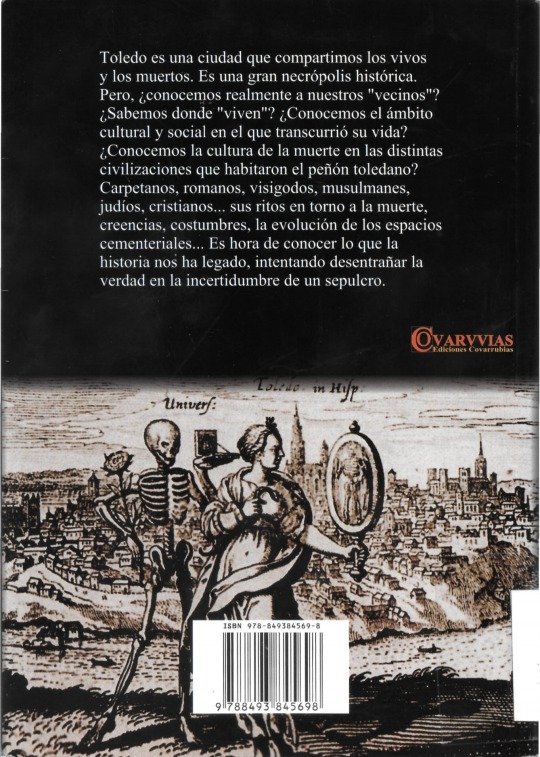
Backcover
Toledo is a city that the living and the dead share. It is a great historical necropolis. But do we really know our "neighbors"? Do we know where they "live"? Do we know the cultural and social environment in which their lives were spent? Do we know the culture of death in the different civilizations that inhabited the crag of Toledo? Carpetans, Romans, Visigoths, Muslims, Jews, Christians... their rites around death, beliefs, customs, the evolution of cemetery spaces... It is time to know what history has left us, trying to unravel the truth in the uncertainty of a tomb.
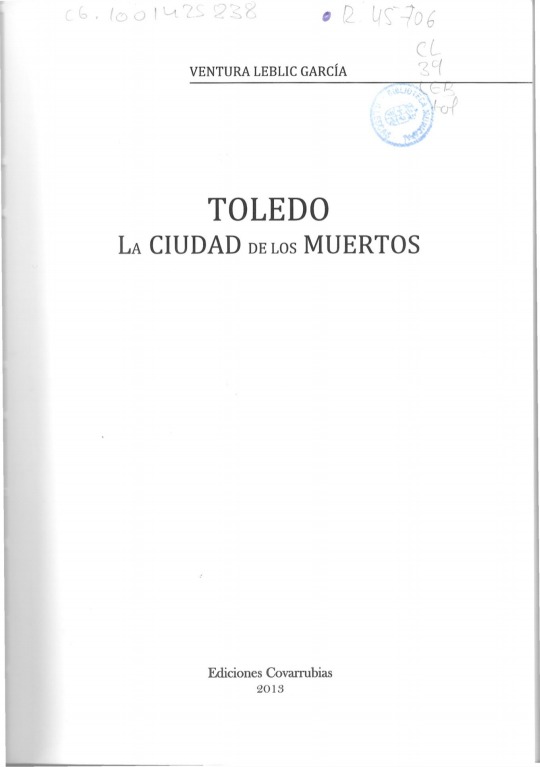
Toledo: The City of the Dead
Ventura Leblic García
Covarrubias Editions 2013

INDEX
Introduction. Page 9
Chapter I. Funerary practices in ancient times. Page 12
The indigenous people. Page 14
Chapter II. The cemetery spaces outside the walls of Toledo. Page 19
Roman cemeteries. Page 19
The early Christian cemetery. Page 24
Visigoth times. Page 31
Toledo's maqbara. The Muslim cemetery. Page 38
Toledo's Mozarabic cemeteries. Page 47
The Jewish cemetery. Page 50
Chapter III. The interior of churches as cementary spaces. Page 63
Chapter IV. Parish cemeteries. Page 70
Chapter V. The cemetery and the municipal cemetery. Page 103
Chapter VI. Royal burials in Toledo. Page 112
The New Kings Chapel. Page 136
New chapel. Page 139
Royal funerals in Toledo. Page 144
Chapter VII. Tombs of royal lineage in Toledo. Page 149
Chapter VIII. Other tombs in Toledo of people who made history. Page 170
The tomb of Doménikos Theotokópoulos "El Greco". Page 178
A frustrated pantheon of illustrious men. Page 182
Don Álvaro de Luna and Doña Juana de Pimentel. Page 188
An empty tomb for four hundred years. Page 191
The tomb of Cardinal Mendoza. Page 194
Francisco de Pisa. Page 196
The flying priest. Bartolomeu Lourenço de Gusmão. Page 197
Chapter IX. The Cistercian monastery of Monte Sión. A case of pantheon foundation. Page 201
The graves. Page 204
Chapter X. Bodies of saints and blesseds venerated in Toledo. Page 215
Chapter XI. Those who did not return. Page 232
Saint Ildefonso of Toledo. Page 232
Grave of Alfonso VI, king of Castile. Page 237
Alfonso X the Wise. Page 239
Francisco Jiménez de Cisneros. Page 240
Queen Joanna I of Castile. Page 242
Alfonso III de Fonseca, archbishop of Toledo. Page 243

Juan de Padilla. Page 244
Francisco de Rojas. Page 248
Cardinal Lorenzana. Page 249
Bibliography. Page 251
#books#toledo la ciudad de los muertos#toledo the city of the dead#ventura leblic garcía#history#pre-roman history#carpetan history#roman history#visigothic history#carpetania#hispania#jewish history#sefarad#sepharad#muslim history#al andalus#christian history#death rites#ancient history#medieval history#modern history#part 1#toledo#carpetan culture#roman culture#visigoth culture#christian culture#jewish culture#islamic culture#carpetans
2 notes
·
View notes
Note
Ana, hello! I saw you posted about tv shows/movies a while ago,and so my ask was regarding that. Are there any movies you (or your followers) know that heavily depict Portuguese Sephardic Jews? The only one I know is The Strange Case of Angelica, whose main character is a Sephardic Jew but afaik it doesn't delve much into it (Disclaimer: I never watched it,just read the summary).
Sefarad is about the Jewish community of Porto and set in the year 1496, when the order of expulsion happened
1618 is a movie about the Inquistion's persecution of crypto Jews in the city of Porto, focused specifically on one family.
They are both portuguese productions and look to have really good quality, from the costuming, to the set, to the actors (no major actors too, which is super refreshing)
19 notes
·
View notes
Text
SEPHARDIC BNEI ANUSIM IN BRAZILIAN TELENOVELAS AND MINISSERIES
@themousefromfantasyland @gravedangerahead @tamisdava2 @princesssarisa @professorlehnsherr-almashy @the-blue-fairie @amalthea9 @faintingheroine @budcortfancam
A Converso, Marrano, New Christian, Crypto-Jew: these terms are intermittently applied to the men and women of 15th-17th century Spain and Portugal whose identities lingered somewhere between Jews and Christians. In most cases, multiple labels can be used to describe the same individuals, because the boundaries between their identities were porous. For both contemporary observers and for modern historians, the label used reveals more about the labeler than about the phenomenon described.
Jews first settled in the Iberian Peninsula, (the region now known as Spain and Portugal) before the arrival of the Phoenicians in about 900 BCE. Jewish merchants settled along the coast of Spain during the time of King Solomon when this region was called Tarsus, or Tarshish. Iberia was referred to as Sefarad by its Jewish inhabitants and Hispania by the Romans from which the name “Spain” was later derived. More Jews immigrated after the destruction of the First Temple in Jerusalem. When the Babylonian king Nebuchadnezzar conquered Jerusalem, there were already large well-established Jewish settlements throughout Iberia.
The first recorded persecution of Jews in Spain began about 489 CE when Jews were forbidden to marry non-Jews or to hold public office, and any children already born of inter-marriage were forcibly baptized into the Catholic Church.
From this time forward, the Iberian Jews were periodically subjected to progressively worse persecution until finally from 653 to 672 CE, Jews were beheaded, burned alive, or stoned to death for the crime of relapsing from forced conversion to Catholicism back into Judaism. It was during the period of 489 to 711, under Frankish and Visigothic rule, that Crypto Jews (Secret Jews) first emerged as a large group.
In 711 CE the Moors of northern Africa conquered the region and there resulted approximately three hundred years of what is known as the “Golden Age of Tolerance,” when the Muslim rulers coexisted with Jews and Christians. Non-Muslim people were allowed great freedom as long as they paid a special tax, to which the Jews gladly agreed. Jewish art, music, medicine, education and religious study flourished, and the Jewish population increased greatly and prospered, many Jews becoming fabulously rich and famous.
During the Golden Age, Spain became the world center for Talmudic Studies, with some of the world’s most famous rabbinical academies. Some of the greatest Jewish scholars lived in Moorish Spain during the years of transition just after the end of this period of time. Rabbi Abraham ben Meir Ibn Ezra was born in Tudela, Spain, in 1089. He was a poet, mathematician, grammarian, astronomer, commentator of Torah and philosopher. Rabbi Moshe ben Maimon, known as “The Rambam” or “Maimonides,” was born in Cordoba, Spain, in 1135, and earned his living as a physician. He is most famous for his codification of Jewish law, entitled Mishne Torah, and for his philosophical work Guide for the Perplexed. Rabbi Moshe ben Nachman, known as “The Ramban,” was born in 1194. He, like Maimonides, was a physician and scholar who was the first to incorporate Cabala, or Jewish mysticism, into the Torah teaching, and was a strong proponent of taking possession of the land of Israel. Jews and Crypto Jews flourished in relative peace and plenty, enjoying the Golden Age and the free exchange of ideas, a relatively high level of education for that time in the world, and the benefits from living among Torah and Talmudic scholars. Cities such as Lucena, Granada and Tarragona were populated by Jews magnificently wealthy in culture and material goods.
However, the so-called Golden Age in Spain was also marked by occasional violent upheavals and political turmoil that affected the Jews and Crypto Jews, who were subject to the whims of the frequently changing governments. For example, violence erupted in 1002, when two politically powerful and wealthy Muslims fought to rule Granada; unfortunately the Jews had backed the loser and suffered from Muslim suspicion thereafter. In 1066 a Jewish chief minister of Granada was crucified, followed by the slaughter of more than 1500 Jewish families. The original Moorish dynasty was overpowered by the fanatical Muslim Almoravides in 1086, who were in turn overpowered by the even more fanatical Muslim Almohades from Morocco in 1112. By 1149 the Almohades had overrun the entire peninsula which had become fragmented into about twelve small kingdoms. The lack of centralized control caused constant power struggles among neighboring kingdoms, such that the Almohades were unable to gain a strong hold on the peninsula.
Although the Jews had coexisted relatively peacefully with the Muslims, the Catholics bitterly resented the loss of Christian control of the peninsula since 711 and had perpetuated unrest and uprisings, and by 1212, outright rebellion. The centuries-long “Reconquista,” or reconquest, of the entire region was considered a holy obligation. Unfortunately, to the Christians, the Jews were identified with the death of their Christ and with the Muslim rulers under whom the Jews had enjoyed privilege and power. Also during this period of time, the Black Plague was ravaging Europe, killing as many as one in every four people, but far fewer of the Jewish population. Relatively few Jews died from the Plague perhaps because of better hygiene. Jews washed their hands before eating bread, bathed weekly prior to Shabbat and before holidays, washed their clothing regularly, maintained sanitary households (especially the kitchen and toilet facilities), consumed only fresh and kosher meats from healthy animals, were required to be distant from sewage and other forms of uncleanliness when reading Torah, and buried their dead within twenty four hours. All of these practices in combination with segregated all-Jewish neighborhoods provided some measure of protection from the Plague, albeit not total immunity. The Catholics did not observe such hygienic lifestyles, and seldom washed or bathed. The Catholics hated the Jews for their apparent immunity to the Plague, and widely believed the canard that the Jews were the source of the “Black Death” by poisoning wells.
The Catholics united against the Muslims who were absorbed in fighting one another and slowly took over most of the small kingdoms, one by one. Catholic rule was not kind to the Jews. Widespread pogroms in 1391 resulted in the deaths of fifty thousand Jews, such that, in fear for their lives, tens of thousands converted to Catholicism. These people were called “Conversos” (converts), “New Christians”, and “Maranos” (a derogatory term meaning “pig people.”) In 1412, the Laws of Catalina were promulgated, which excluded Jews from any economic interchange with Christians. From this time until the Edict of Expulsion in 1492, Jews were strictly confined to ghettos and had to wear identification badges prominent on the outside of their clothing. Hard-pressed to survive, many Jews, perhaps as many as 600,000, converted to Christianity by the end of the fifteenth century. Many of the New Christians were in reality Crypto Jews, outwardly Christians, but tenaciously and secretly practicing Judaism.
The Spanish Edict of Expulsion of 1492 stated that all Jews must leave the country. Those who stayed faced the Inquisition. A small number fled to Italy, Amsterdam, and the Americas, but most went to neighboring Portugal. When the Inquisition came to Portugal in 1496, the Jews were forced to leave, convert, or die. Of those Conversos who opted not to emigrate, many, if not most, were murdered by the “Holy” Inquisition. By 1500, estimates of as few as 40,000 and of more than 200,000 Jews were forced to leave the Iberian Peninsula. Exact numbers are not available because many of the Crypto Jewish family names had been changed after the pogroms of the 1300s in anticipation of future persecution.
The Spanish and Portuguese Inquisition continued for three hundred and fifty years. Accurate recorded accounts of the names, numbers, dates and punishments were kept by the officers of the Inquisition, such that today anyone who cares to recount the horrors may read of them. Of those Jews and Crypto Jews who chose to not leave, or could not afford to leave the Iberian Peninsula, many later bought passage or a commission on a sailing ship bound for safer destinations, preferably as far as possible from the nearest Office of the Inquisition.
Some purchased the proper documentation for “temporary” (which frequently became permanent) business trips to Italy or Germany, whereas poorer people fled to the north through the mountains and into France. Entire communities of “Portuguese Christians” were documented in southern France, while others continued northward to Amsterdam, England, Scandinavia, and eastward to the German provinces, Austria, Hungary and Poland. In most of these European destinations, these “Portuguese Christians” eventually revealed their true identity as Jews, and then subsequently blended into the established Jewish populations; thus, we do not find long histories of Crypto Judaism throughout Europe.
Many Jews and Crypto Jews immigrated to the New World, now known as the Americas, or the Western Hemisphere. Their choices were limited to the colonies of Spain and Portugal, so that when the Inquisition came to Peru in 1570, to Mexico in 1571, and to Cartagena in 1610, these same people were forced again to choose to convert or to die. The Inquisition spread throughout what is now the southern United States of America, Mexico, Central and South America, the islands of the Caribbean, and Cuba. No Jew or "Converso" was safe from suspicion, accusation and persecution, thus the numbers of Crypto Jews swelled to encompass almost all people of Jewish descent. The experience of the Crypto Jews in the Western Hemisphere was a litany of suffering, continual fear, social, political, professional, and religious suppression and murder. As late as the 1850s the Inquisition was finally officially ended in Mexico, and elsewhere a little sooner; however, overt discrimination and random incidents of lynching and murder continued until well into the 1950s in what we now call "Latin America".
The final result of approximately one thousand years of persecution and murder of the Spanish and Portuguese Jews (minus the three hundred years of the "Golden Age") caused many families who immigrated to the New World to become Crypto Jewish, while living their public lives as Catholics. In the Americas, some of the Crypto Jews reverted to being openly Jewish, only to find a few years later that the Inquisition had followed them to their new homes, and they were forced to go back into hiding again. All of these people, the "Conversos" or "New Christians", were forced to submit to Catholicism, thus in Hebrew they are referred to as the "Anusim" or "those who were forced."
It has been approximately fifteen-hundred years since the emergence of Crypto Jews in the Iberian Peninsula, and five-hundred years since Crypto Judaism moved to the Americas. Today we find a large Crypto Jewish presence throughout the Western Hemisphere. No one knows for sure how many there really are, however in Brazil alone an estimated 10 to 25% of the total population are Crypto Jews, which translates to 15 to 40 million people.
Some period setting audiovisual productions in Brazil took interest in the history of the Anusim during the colonial period, and two teleivision productions included Anusim characters as main figures in their narratives.
Xica da Silva (1996-97)
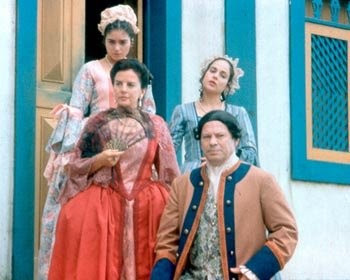
This telenovela produded by Rede Manchete, set in 18th century Brazil, told the story of Xica da Silva, a black woman who was born in Brazil and was enslaved, until a white and rich portuguese man named João Fernandes fell in love with her, made her his lover and gave her freedom, making her one of the most rich and powerfull people of Arraial of Tijuco (now the city od Diamantina, Minas Gerais).
Among the side characters who were part of Xica da Silva and João Fernandes's story, were the Pereira family, who were jewish people that came from Portugal to Brazil hoping to escape the Inquisition, and were atracted to the Arraial of Tijuco because of the diamonds that were found there.
Teodoro (António Marques) was the patriarch, Guiomar (Lídia Franco) was his wife (who threw tantrums when she saw a slave naked) and Joaquina (Rosa Castro André) and Graça (Anabela Teixeira) were his daughters.
Both sisters were in love with the gentile travelling merchant Felix (Jayme Periard) who, despite loving Graça, is forced by tradition to marry Joaquina (in a plot inspired by the hebrew tale of how Laban tricked Jacob to marry Leah, despite having promised the hand of Rachel).
Like most characters in the narrative, being to the historical period being portrayed on screen, the Pereiras were slave owners, and Teodoro sexually abuses Fatima (Ilea Ferraz), one of the black woman who is enslaved in his house, and this results in the conception of an illegitimate child.
Later, when Fatima falls in love with another enslaved black man named Jerônimo (Alexandre Moreno) the two join forces to find a plan to take revenge on the Pereira family and get their freedom.
This plan takes form during the visit of a representative of the Inquisition to Arraial of Tijuco: The two reveal to the Inquisitor that the Pereiras had a 7-pointed candlestick (which the representative recognizes as a description of the jewish menorah), hidden in a chest.
At the end of the telenovela, the Pereiras are put under arrest by orders of the Inquisitor, who will take them to trial in Portugal. Felix comes to rescue one of the women, and the baby he had with Joaquina. Joaquina is to ill to run with him trough the woods, so she sends her sister Graça (who she always knew was Felix's true love) to go with him and her child, and Guiomar asks her son-in-law to take away the family's menorah, so her grandson will always remember his jewish origin.
Xica da Silva was a story of black and gray morality: most characters were capable of being simpathetic, and also held prejudiced beliefs and take part in cruel acts, because those were normalized by the political system, rather than a question of individual morals.
This ambiguity was also shown in the Pereiras, who were both victims of opression for being targets of antisemitism, and perpetrators of opression for participating in the widespread enslavement of black people, when owning slaves was considered prestigious and respectable.
A Muralha (2000)

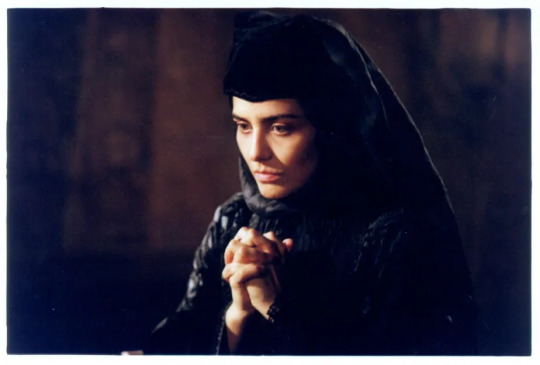
In the year of 2000, during the 500th anniversary of the arrival of the portuguese squad to brazilian shores (which started the proccess of colonization), Rede Globo produced a minisseries set in the early 17th century called A Muralha (literal translation The Wall, titled The Conquest for international markets) , based on a novel written by Dinah Silveira de Queiroz, that told about the everyday life of the people who lived trough the proccess of colonization, economic exploitation and territorial expansion led by the portuguese and their descendants born here, during the period known as "Bandeiras".
The point of view which we followed those stories was primarily of the women living through that period, and one of these women was the portuguese jewish Dona Ana Cardoso (Letícia Sabatella), who arrives in Brazil to get in an arranged marriage to Dom Jerônimo Taveira (Tarcísio Meira).
Dona Ana owes a moral debt to Dom Jerônimo: he is the brother of the inquisitor who saved her father from death in Portugal. Falsely converted to Catholicism and originally resigned to her fate, Dona Ana's resignation is put into question when she is courted by the rich merchant Dom Guilherme Shetz, a libertine man who lives in harmony with nature and the Indigenous people.
The man who marries Dona Ana, Dom Jerônimo, knows how to be a scoundrel and a pretender before the authorities, but he does not respect them, and he is foolish towards the priests, but in reality he is a cruel man, who imprisons Ana on his property to satisfy his most perverse desires.
After denouncing several residents to the Inquisition for alleged heresy, Dom Jerônimo orders the arrest of those who defy his authority, including Ana and Guilherme. To everyone's astonishment, everyone is condemned to the stake. But Guilherme stabs the villain, who ends up dead in one of the fires he lit himself.
Ana and Guilherme run to live in a cabin built in the woods, and end the story living happy, expecting their first child.
Another jewish character present in the narrative was the jolly Master Davidão (Pedro Paulo Rangel): whereas Ana is more resignated, Master Davidão, while also being carefull in hiding his jewish faith, is more confident and optimistic, not letting himself be afrayed of those in power.
His joifull personality and kidness eventually win the love of Antônia Brites (Claudia Ohana), a former prostitute who came to Brazil in search of a happy marriage, and at the end, having also survived the rage of Dom Jerônimo, the two get married.



While Davidão and Ana refused to convert to Christianity, Simão (Paulo José) was an Anusin who fully embraced it years prior, having become a priest and acting as a leader of the Jesuit Order that comes to the colonies to convert the natives.
His position was in a complex middle ground: While he really believed in Christianity as the only path to salvation, he also called out those who, like Dom Jerônimo and the Inquisition, wanted to impose it trough violence, and frequented acted as a healer and confident of Dona Ana in the moments where she was enduring abuse.
Whereas Xica da Silva was more dark and dealt in black-and-gray morality, A Muralha had more heroic characters, who represented the views on the search for social progress among those who viewed religious and racial hierarchy as natural.
#judaism#jewish representation#the history side of tumblr#brazil#telenovelas#being a child in latin america
13 notes
·
View notes
Text

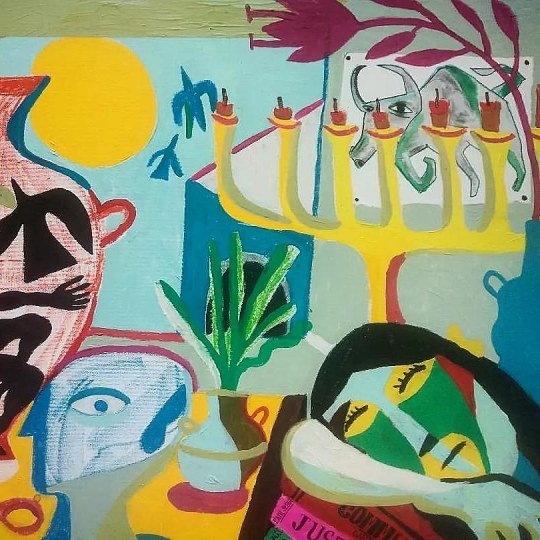
“Siesta in the Studio on a Summer Afternoon”
My studio is a true reflection of my recurrent obsessions,
everything and everyone is here:
The Phoenicians and the Greeks,
the Celts and the Al-Andalus,
the Menorahs and the keys of Sepharad,
the poets and the books,
Matisse and Picasso,
the plants and the sea,
the desert and the sky,
the Tuscany and the Veneto,
the bulls and the birds,
the vivid dreams and the painted dreams,
both by way of prediction.
Oil sticks, acrylic paint, charcoal and marker on canvas.
80 x 100 cm.
Mi estudio es un fiel reflejo de mis obsesiones recurrentes,
todo y todos están aquí:
Los fenicios y los griegos,
los celtas y al-Andalus,
las Menorahs y las llaves de Sefarad,
los poetas y los libros,
Matisse y Picasso,
las plantas y el mar,
el desierto y el cielo,
la Toscana y el Véneto,
los toros y los pájaros,
los sueños vívidos y los sueños pintados,
ambos a modo de predicción.
Barras de óleo, pintura acrílica, carboncillo y rotulador sobre lienzo.
#studio#oscarrey#oscarangelreysoto#flowers#artiststudio#oreystudio#taller#summer#greekvase#matisse#contemporaryart#birds#markers#sefarad#picasso#artistonInstagram#contemporary#bull#pattismith#Malerei#alandalus#joesacco#fineart#dante#menorah#Tuscany#veneto#windowview
21 notes
·
View notes